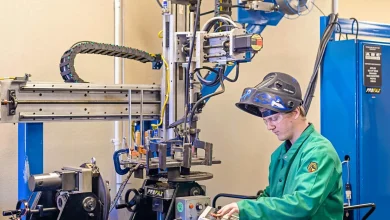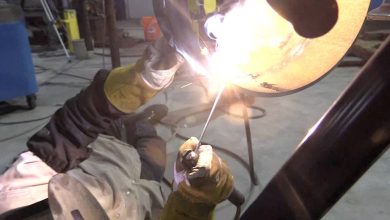How to Get More Penetration Mig Welding
To get more penetration in MIG welding, there are a few key steps you can take.
First, increasing the gap or using a V bevel can improve full penetration.
Additionally, lifting the piece off the table helps prevent heat absorption, allowing for better penetration.
Maintaining a torch angle of 10-20 degrees is important, as is keeping stickout tight for better wire bite into the metal.
Holding the torch straight on can reduce splatter and cleaning the metal thoroughly has a positive impact on results.
Finally, using a 190-amp welder should be sufficient for achieving the desired penetration.
Check this out:
Did You Know?
1. When it comes to achieving more penetration in MIG welding, adjusting the travel speed is key. Slowing down the travel speed can result in deeper penetration, as it allows the filler metal more time to melt and merge with the base metal.
2. The angle at which you hold the MIG welding gun can also affect penetration. Tilting the gun slightly towards the direction of travel can increase penetration by directing the heat and arc deeper into the weld joint.
3. Using a narrower welding wire diameter can lead to increased penetration. Thinner wires have a higher current density, which results in a more concentrated heat input, allowing for greater penetration.
4. Preheating the base metal before MIG welding can significantly enhance penetration. By raising the temperature of the material, preheating ensures that the weld metal can fuse more effectively with the base metal, resulting in deeper penetration.
5. The composition of the shielding gas can impact penetration in MIG welding. Opting for a higher percentage of helium in the shielding gas mixture, rather than pure argon, can increase the heat transfer rate and promote deeper penetration.
Increase The Gap Or Use A V Bevel
To achieve better penetration in MIG welding, there are two options: increasing the gap between the pieces being welded or using a V bevel.
Increasing the gap allows for better access and penetration of the weld. For thin materials, a gap of one to two times the material thickness is recommended. However, for thicker materials, a larger gap may be necessary. It is important to consult with a welding professional or refer to welding codes and standards for guidance on determining the optimal gap size.
Using a V bevel provides a wider area for the weld to fill, ensuring full penetration. This method enhances the strength and integrity of the weld.
In conclusion, both methods mentioned above can significantly improve the penetration in MIG welding and enhance the welding quality.
Lift The Piece Off The Table
One common mistake made in MIG welding is allowing the workpiece to rest directly on the welding table. This can lead to heat absorption by the table and inefficient heat transfer into the workpiece. To prevent this, it is crucial to lift the piece off the table using suitable supports or clamps.
By lifting the piece off the table, heat transfer is improved, resulting in better penetration. Additionally, it reduces the risk of distortion in the workpiece due to uneven heating and cooling. It is advisable to use heat-resistant materials for supports or clamps to prevent them from warping or melting under the welding heat.
- Avoid resting the workpiece directly on the welding table
- Lift the piece off the table using suitable supports or clamps
- Improve heat transfer for better penetration
- Reduce distortion caused by uneven heating and cooling
- Use heat-resistant materials for supports or clamps
Maintain A Torch Angle Of 10-20 Degrees
The torch angle is crucial for achieving high-quality penetration in MIG welding. Maintaining a torch angle of 10-20 degrees is recommended, depending on the specific welding application. This angle allows for effective heat concentration, proper fusion, and consistent penetration.
- If the torch angle is too steep, the weld pool may not fully penetrate, resulting in weak and unreliable joints.
- Conversely, if the angle is too shallow, excessive heat and splatter can occur, leading to a lack of control and potential burn-through.
Practicing the correct torch angle and adjusting it as needed for different joint configurations is essential for achieving optimal penetration.
Keep Stickout Tight
Stickout, in welding, refers to the length of the wire electrode extending from the contact tip of the welding gun. By maintaining a tight stickout (shorter length of exposed wire) during welding, it is possible to achieve better wire bite into the metal, which ultimately improves penetration.
On the other hand, when stickout is too long, the distance traveled by the wire from the contact tip to the weld pool increases. As a result, more resistance and a greater voltage drop occur. This extended stickout can lead to reduced penetration and increased spatter. However, by keeping the stickout tight, the wire distance is minimized, enabling better control and improved penetration.
To summarize, the advantages of maintaining a tight stickout in welding include:
- Better wire bite into the metal
- Improved penetration
“Tight stickout” refers to the practice of maintaining a shorter length of exposed wire from the contact tip of the welding gun to achieve better control and penetration.
Hold The Torch Straight On
Maintaining a straight-on torch position while MIG welding is key to achieving more penetration. Holding the torch straight on ensures that the arc energy is concentrated on the joint, leading to effective fusion and penetration.
Deviation from a straight-on torch position, such as angling it too much in any direction, can result in reduced penetration and inconsistent bead shape. It is crucial to maintain a stable and balanced torch grip, enabling smooth movement along the joint while maintaining a straight-on position. Practice and proper body positioning can significantly help in achieving this.
- A straight-on torch position is essential for achieving more penetration.
- Deviating from the straight-on position can result in reduced penetration and inconsistent bead shape.
- Maintaining a stable and balanced torch grip is crucial for smooth movement along the joint.
- Practice and proper body positioning greatly contribute to achieving and maintaining a straight-on torch position.
Thoroughly Clean The Metal
Proper cleaning of metal surfaces is essential for achieving optimal penetration in MIG welding. Contaminants like dirt, grease, rust, or paint can hinder fusion and weaken joints.
To thoroughly clean metal surfaces, use appropriate methods such as wire brushing, grinding, or chemical cleaning, depending on the type of contamination. It is critical to remove any oxide layers, mill scales, or corrosion, as they can interfere with fusion and penetration. By ensuring clean and oxide-free surfaces, proper fusion and penetration can be promoted, contributing to the overall quality of the weld.
Implementing these essential tips can help welders enhance their MIG welding skills and achieve improved penetration. Each tip addresses a specific aspect of the welding process, including gap adjustment, torch angle, stickout control, and metal cleanliness. Remember that practice and experience are crucial in mastering these techniques. Keep welding, continuously improve, and create stronger and more reliable welds.
- Thoroughly clean the metal surfaces
- Use appropriate cleaning methods (wire brushing, grinding, or chemical cleaning)
- Remove oxide layers, mill scales, or corrosion
- Ensure clean and oxide-free surfaces
- Practice and gain experience in mastering MIG welding techniques.
Frequently Asked Questions
How do you get penetration when MIG welding?
To achieve penetration when MIG welding, it is crucial to carefully consider the travel angle. By setting the travel angle between 0° to 10°, the electrode is positioned perpendicular or mostly perpendicular to the plate. This orientation allows for enhanced weld penetration as it directs a greater amount of the arc force down into the base plate. Therefore, by manipulating the travel angle, welders can effectively control the level of penetration in MIG welding processes, ensuring strong and durable welds.
What causes poor penetration in MIG welding?
Poor penetration in MIG welding can be attributed to various factors. One possible cause is the narrowing or closing up of the root gap as welding progresses. This restricted space inhibits the proper flow of molten metal into the root, resulting in incomplete fusion and penetration. Another factor could be an excessively thick root face or a root gap that is too small in a butt weld. These conditions create difficulties for the molten metal to adequately penetrate the joint, leading to poor penetration. Additionally, misplaced welds or excessive welding speed can also contribute to ineffective penetration as they can disrupt the optimal heat transfer and distribution required for successful fusion.
How do you fix lack of penetration in welding?
To address the issue of lack of penetration in welding, it is crucial to consider several factors. Firstly, ensuring an adequate level of amps is essential for achieving proper penetration. By adjusting the amperage settings accordingly, the welding process can produce sufficient heat and current flow required for effective penetration.
Secondly, selecting an appropriately sized welding stick is crucial. Utilizing a stick that is too small may result in insufficient heat input, leading to inadequate penetration. Conversely, employing a stick that is too large can create excessive heat and potentially burn through the metal instead. Striking the right balance is key.
Additionally, it is important to pay attention to the gap between the metal pieces being welded. A gap that is too large can hinder proper penetration. By ensuring a suitable gap size, the welder can improve the accessibility of the welding materials, enabling sufficient heat and penetration during the welding process.
Furthermore, maintaining an adequately heated torch is imperative for achieving optimal weld penetration. The torch needs to reach the required temperature to effectively melt the metal and create a strong bond. Adjusting the temperature settings and implementing proper preheating techniques ensures that the torch is hot enough for the specific thickness of the metal being welded.
Lastly, when gas welding, clamping both pieces together can enhance the strength of the weld. This technique enables better alignment and stability between the metal pieces, facilitating both penetration and overall weld quality.
By considering these factors and implementing the appropriate adjustments, welders can effectively address the lack of penetration and ensure strong, durable welds.
What is the best motion for MIG welding?
The best motion for MIG welding thick steel is to maintain a steady torch movement while avoiding excessive filler deposition. To enhance the weld quality, one can adopt a technique where the torch movements overlap slightly, resembling a cursive “i”. This involves gently touching the torch into the edge of the weld puddle before proceeding forward. Such a method ensures precise control and optimal fusion of the metals being welded.


